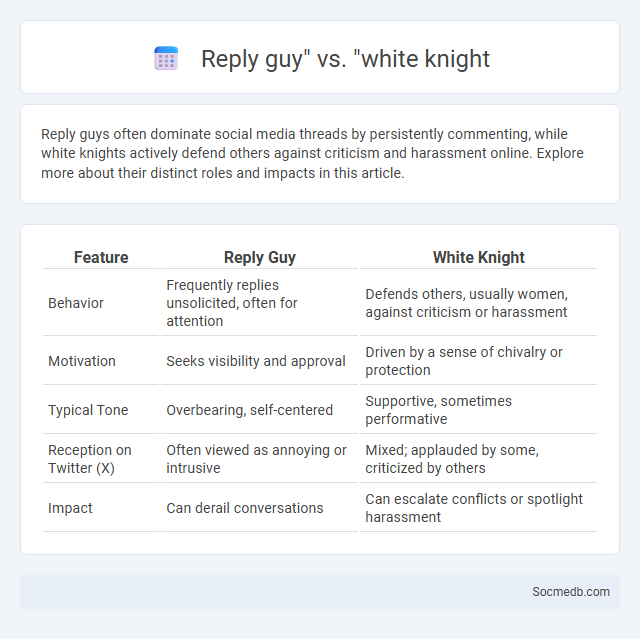
Photo illustration: Reply guy vs white knight
Reply guys often dominate social media threads by persistently commenting, while white knights actively defend others against criticism and harassment online. Explore more about their distinct roles and impacts in this article.
Table of Comparison
| Feature | Reply Guy | White Knight |
|---|---|---|
| Behavior | Frequently replies unsolicited, often for attention | Defends others, usually women, against criticism or harassment |
| Motivation | Seeks visibility and approval | Driven by a sense of chivalry or protection |
| Typical Tone | Overbearing, self-centered | Supportive, sometimes performative |
| Reception on Twitter (X) | Often viewed as annoying or intrusive | Mixed; applauded by some, criticized by others |
| Impact | Can derail conversations | Can escalate conflicts or spotlight harassment |
Understanding the "Reply Guy": Definition and Traits
The "Reply Guy" refers to a social media user known for persistently responding to posts, often with unsolicited advice, corrections, or commentary. Typical traits include a tendency to monopolize conversations, display performative expertise, and seek validation through frequent engagement. Understanding this behavior is essential for managing online interactions and fostering healthier digital communication environments.
Decoding the "White Knight": Who They Are Online
The "White Knight" in social media refers to users who frequently intervene in online conflicts to support others, often driven by a strong sense of justice or loyalty. These individuals tend to defend targeted users against trolls, cyberbullies, or controversial opinions, shaping the dynamics of digital interactions. Understanding their motivations and impacts helps decode social media behaviors and the complex ecosystem of online support networks.
Key Differences: Reply Guy vs. White Knight
Reply Guys often seek attention by persistently commenting on posts, aiming to insert themselves into conversations without adding substantial value. White Knights typically defend others online, especially in situations involving injustice or harassment, motivated by a desire to uphold social justice. Understanding these distinctions helps you navigate social media interactions more effectively and recognize genuine support versus performative engagement.
Motivation and Behavior: What Drives Online Interactions?
Social media interactions are primarily driven by intrinsic motivations such as the desire for social connection, self-expression, and validation through likes and comments. Behavioral patterns reveal that users engage more actively when content aligns with their identity, emotional state, or social goals, reinforcing their sense of belonging and status. Psychological factors like dopamine release linked to notifications and algorithm-driven content personalization further amplify engagement and shape online behavior.
The Impact of Reply Guys on Digital Conversations
Reply Guys significantly alter digital conversations by flooding comment sections with unsolicited opinions, often derailing discussions and overshadowing original content. Their persistent replies can frustrate users, diminishing the quality of online interactions and discouraging genuine engagement. Protecting Your social media experience involves recognizing and managing these disruptive behaviors to maintain meaningful dialogue.
White Knighting: Harmless Help or Performative Allyship?
White Knighting on social media often manifests as unsolicited defense of others, aiming to portray oneself as a noble protector rather than addressing the core issue. This behavior blurs the line between genuine allyship and performative gestures, potentially overshadowing the voices of those truly impacted. Understanding the motivations behind White Knighting is crucial for fostering authentic support and encouraging constructive online activism.
Case Studies: Real-World Examples of Each Archetype
Case studies reveal how social media archetypes like the Influencer, Brand Advocate, and Social Listener drive engagement and brand loyalty. For instance, Nike's use of Influencers demonstrates massive reach through athlete endorsements, while Apple's Brand Advocates create authentic user-generated content that boosts trust. Starbucks excels in Social Listening by monitoring customer feedback to innovate offerings and improve service in real time.
Community Responses: How Social Media Handles Them
Social media platforms utilize advanced algorithms to monitor and categorize community responses, enabling real-time analysis of user sentiment and engagement patterns. Features like comment moderation tools, sentiment analysis, and AI-powered filters help in managing negative feedback while promoting positive interactions. Platforms such as Facebook, Twitter, and Instagram invest in machine learning models to detect harmful content and enforce community guidelines efficiently.
Navigating Online Etiquette: What’s Helpful, What’s Harmful
Navigating online etiquette involves recognizing respectful communication, such as using clear language and respecting diverse perspectives, which fosters positive interactions on social media platforms like Facebook, Twitter, and Instagram. Avoiding harmful behaviors like cyberbullying, spreading misinformation, and engaging in harassment is crucial to maintaining a safe digital environment. Understanding platform-specific norms and employing digital empathy enhance social connectivity and reduce conflict in virtual communities.
Evolving Roles: How Internet Culture Shapes These Personalities
Internet culture continuously transforms social media personalities, influencing their content style, engagement tactics, and public personas to align with emerging trends and audience expectations. Algorithms and viral challenges drive creators to adapt, fostering innovation in storytelling and community interaction. Your online presence thrives when you embrace these evolving dynamics, leveraging cultural shifts to maintain relevance and deepen connections.
 socmedb.com
socmedb.com